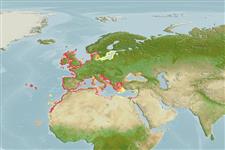Environment: milieu / climate zone / depth range / distribution range
экология
морской; пресноводный; солоноватоводный; катадромный (Ref. 59043); пределы глубины 10 - 20 m (Ref. 30578). Temperate; 60°N - 15°N, 32°W - 42°E
Eastern Atlantic: from the coasts of southern Norway to Cape Verde, including the Mediterranean and the Black Sea (Ref. 2804, Ref. 51442, 116118). Records of its occurrence in tropical waters are based on misidentifications (Ref. 3573).
Length at first maturity / Size / Вес / Возраст
Maturity: Lm 25.9, range 25 - 32 cm
Max length : 70.0 cm TL самец/пол неопределен; (Ref. 4645); common length : 35.0 cm TL самец/пол неопределен; (Ref. 3646); наибольший вес (опубликованные данные): 2.9 kg (Ref. 40476); наибольший возраст (опубликованны данные): 10 годы (Ref. 40476)
колючие лучи спинного плавника (общее число) : 4 - 5; членистые (мягкие) лучи спинного плавника (общее число) : 7 - 10; колючие лучи анального плавника: 3; членистые (мягкие) лучи анального плавника: 8 - 9. Fusiform body (Ref. 51442). Massive head, flattened above the eyes (Ref. 51442). Small mouth (Ref. 51442). Snout short and blunt (Ref. 51442). Two dorsal fins well-separated, the first with 4 to 5 spines (Ref. 40476, Ref. 51442). Pectoral fins are placed high on the flanks (Ref. 51442). Large scales (Ref. 51442). Dorsal sides and flanks gray-colored, ventral side white (Ref. 51442).
Adults are pelagic occurring near shore, entering lagoons and lower reaches of rivers in schools; often in polluted waters (Ref. 51442, 59043) between temperatures 8-24°C. Juveniles colonize the littoral zone and estuaries (Ref. 51442). Adults feed on epiphytic algae, detritus and small benthic or planktonic organisms, pelagic eggs and larvae while juveniles feed on zooplankton until about 3.0 cm SL, then on benthic animals and plants (Ref. 59043). Spawning takes place at sea near the coast between September and February (Ref. 30578, 51442). Oviparous, eggs are pelagic and non-adhesive (Ref. 205). Adults undergo migrations (Ref. 51442).
Spawning takes place at sea near the coast by gathering in groups between September and February (Ref. 51442). The eggs develop at sea (Ref. 51442). The juveniles then colonize the littoral zone and the estuaries (Ref. 51442). Adults enter the lower parts of the rivers and treturn to the sea to spawn (Ref. 51442).
Thomson, J.M., 1990. Mugilidae. p. 855-859. In J.C. Quero, J.C. Hureau, C. Karrer, A. Post and L. Saldanha (eds.) Check-list of the fishes of the eastern tropical Atlantic (CLOFETA). JNICT, Lisbon; SEI, Paris; and UNESCO, Paris. Vol. 2. (Ref. 7399)
Статус Красного Списка МСОП (Ref. 130435: Version 2024-1)
Угроза для людей
Harmless
Использование человеком
рыболовство: коммерческий; аквакультура (рыбоводство): коммерческий; объект спортивного рыболовства: да
дополнительная информация
инструменты
Специальные отчеты
Скачать в формате XML
ресурсы в Интернет
Estimates based on models
Preferred temperature (Ref.
123201): 9.7 - 20.1, mean 11.8 °C (based on 314 cells).
Phylogenetic diversity index (Ref.
82804): PD
50 = 0.5005 [Uniqueness, from 0.5 = low to 2.0 = high].
Bayesian length-weight: a=0.00933 (0.00740 - 0.01176), b=2.96 (2.93 - 2.99), in cm total length, based on LWR estimates for this species (Ref.
93245).
Trophic level (Ref.
69278): 2.3 ±0.20 se; based on food items.
Generation time: 4.4 (3.2 - 7.3) years. Estimated as median ln(3)/K based on 10
growth studies.
устойчивость к внешним воздействиям (Ref.
120179): низкий, минимальное время удвоения популяции 4.5-14 лет (K=0.15; tm=3-5).
Fishing Vulnerability (Ref.
59153): Moderate vulnerability (42 of 100).
Nutrients (Ref.
124155): Calcium = 16.3 [5.2, 148.0] mg/100g; Iron = 0.275 [0.165, 0.453] mg/100g; Protein = 18.2 [16.9, 19.7] %; Omega3 = 1.14 [0.46, 2.94] g/100g; Selenium = 3.21 [1.26, 8.34] μg/100g; VitaminA = 8.98 [2.20, 38.02] μg/100g; Zinc = 0.485 [0.343, 0.670] mg/100g (wet weight); based on
nutrient studies.
